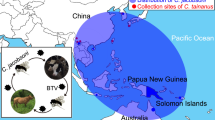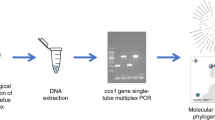Abstract
Due to the severe outbreaks of bluetongue disease (BTD) in the years 2006/2007 in Germany in the absence of the main African vector Culicoides imicola, a rapid and easy applicable method for identification of autochthonous Culicoides spp. had to be developed. Morphological identification is time-consuming, rendering impossible the identification of large numbers of midges in a short period of time. A polymerase chain reaction (PCR)-based procedure in connection with a species-specific primer greatly simplifies the identification process. The region of internal transcribed spacer 1 (ITS-1) of the ribosomal DNA has shown great potential for developing a reliable PCR-based procedure. Culicoides midges were caught with ultraviolet-light traps installed on different farms in Germany during 2007 and 2008. The midges were mounted on slides and morphologically characterised. Midge DNA was extracted and the ITS-1 region amplified using conservative primers. Potential primer regions within ITS-1 were determined and a species-specific Culicoides dewulfi primer was developed to correctly identify autochthonous C. dewulfi, one of the suspected BTV vectors in northwestern Europe. The developed primer was used to identify C. dewulfi in a pool of Culicoides midges from a farm in the state of Brandenburg.




Similar content being viewed by others
References
Benson DA, Karsch-Mizrachi I, Lipman DJ, Ostell J, Wheeler DL (2008) GenBank, D25-30
Boorman J (2006) A guide to the British Culicoides. http://www.iah.bbsrc.ac.uk/bluetongue/culicoides/index.html
Carpenter S, McArthur C, Selby R, Ward R, Nolan DV, Luntz AJM, Dallas JF, Tripet F, Mellor PS (2008) Experimental infection studies of UK Culicoides species midges with bluetongue virus serotypes 8 and 9. Vet Rec 163:589–592
Cêtre-Sossah C, Baldet T, Delecolle JC, Mathieu B, Perrin A, Grillet C, Albina E (2004) Molecular detection of Culicoides spp. and Culicoides imicola, the principal vector of bluetongue (BT) and African horse sickness (AHS) in Africa and Europe. Vet Res 35:325–337
Cêtre-Sossah C, Mathieu B, Setier-Rio M-L, Grillet C, Baldet T, Delécolle J-C, Albina E (2008) Development and evaluation of a real-time quantitative PCR assay for Culicoides imicola, one of the main vectors of bluetongue (BT) and African horse sickness (AHS) in Africa and Europe. Res Vet Sci 85:372–382
Delécolle J-C (1985) Nouvelle contribution a l’etude systematique et iconographique des especes du genre Culicoides (Diptera: Ceratopogonidae) du Nord-Est de la France. These pour le titre de Docteur de l’Universite (Sciences). Universite Louis Pasteur, Strasbourg
Dijkstra E, van der Ven IJK, Meiswinkel R, Holzel DR, Van Rijn PA, Meiswinkel R (2008) Culicoides chiopterus as a potential vector of bluetongue virus in Europe. Vet Rec 162:422
EFSA (2008) Scientific opinion of the Panel on Animal Health and Welfare on a request from the European Commission (DGSANCO) on bluetongue. EFSA J 735:1–69
Li GQ, Hu YL, Kanu S, Zhu XQ (2003) PCR amplification and sequencing of ITS1 rDNA of Culicoides arakawae. Vet Parasitol 112:101–108
Mehlhorn H, Walldorf V, Klimpel S, Jahn B, Jaeger F, Eschweiler J, Hoffmann B, Beer M (2007) First occurrence of Culicoides obsoletus-transmitted bluetongue virus epidemic in Central Europe. Parasitol Res 101:219–228
Meiswinkel R, van Rijn P, Leijs P, Goffredo M (2007) Potential new Culicoides vector of bluetongue virus in northern Europe. Vet Rec 161:564–565
Meiswinkel R, Goffredo M, Leijs P, Conte A (2008) The Culicoides ‘snapshot’: a novel approach used to assess vector densities widely and rapidly during the 2006 outbreak of bluetongue (BT) in The Netherlands. Prev Vet Med 87:98–118
Mellor PS, Boorman J, Baylis M (2000) Culicoides biting midges: their role as arbovirus vectors. Annu Rev Entomol 45:307–340
Nicholas KB, Nicholas HB Jr, Deerfield DWI (1997) GeneDoc: analysis and visualization of genetic variation. In EMBNEW.NEWS 4:14
Perrin A, Cetre-Sossah C, Mathieu B, Baldet T, Delecolle JC, Albina E (2006) Phylogenetic analysis of Culicoides species from France based on nuclear ITS-1-rDNA sequences. Med Vet Entomol 20:219–228
Rozen SSHJ (2000) Primer3 on the WWW for general users and for biologist programmers. In: Krawetz SMS (ed) Bioinformatics methods and protocols: methods in molecular biology. Humana, Totowa, pp 365–386
Wörheide G, Nichols SA, Goldberg J (2004) Intragenomic variation of the rDNA internal transcribed spacers in sponges (Phylum Porifera): implications for phylogenetic studies. Mol Phylogenet Evol 33:816–830
Author information
Authors and Affiliations
Corresponding author
Rights and permissions
About this article
Cite this article
Stephan, A., Clausen, PH., Bauer, B. et al. PCR identification of Culicoides dewulfi midges (Diptera: Ceratopogonidae), potential vectors of bluetongue in Germany. Parasitol Res 105, 367–371 (2009). https://doi.org/10.1007/s00436-009-1407-z
Received:
Accepted:
Published:
Issue Date:
DOI: https://doi.org/10.1007/s00436-009-1407-z




